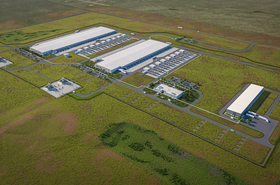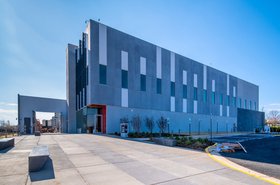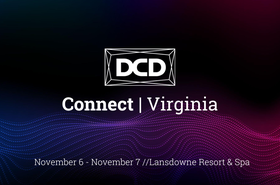Welcome to my 10th annual data center and tech predictions!
Time sure flies when you’re having fun and part of an industry with its hair on fire. I want to thank the good folks at Datacenter Dynamics who have been there since the beginning back in 2015 when I started my annual prognostications with a David Letterman-inspired Top 10 list.
Anyway, on with the predictions where I hit on nuclear power, construction, AI, tax incentives, and more.
1) At least one hyperscaler will submit a license application for a Small Modular Reactor (SMR) in 2024
In my predictions for 2023, I predicted that a data center or cloud operator would sign up for nuclear power. In grading my predictions, I found that I was correct, but the identity of the company is not yet known. With all the momentum behind nuclear power and SMRs, I think this is the next logical step.
Most think it will take 10 years for one of these projects to come to fruition, but you need to start somewhere. In a recent joint meeting between the Federal Energy Regulatory Commission (FERC) and the Nuclear Regulatory Commission (NRC), the NRC said they expect to receive 25 licensing applications in the next five years.
Of course, not all of those will come from data center folks, but with our industry’s insatiable appetite for power, the severe power shortage, and the desire to reduce carbon emissions, data centers will be front and center in the discussions. My money is on it being Microsoft given that they recently hired a director of nuclear development acceleration and a director of nuclear technologies.
2) AI-induced power shortages drive data centers to secondary and tertiary markets
With the much-publicized power shortages in Northern Virginia and many other locations, data centers will have to locate elsewhere if they want to energize their data center anytime in the near future. Simply put, my prediction is that data centers are going to go to places that have power, wherever that may be.
This obviously isn’t a new concept given that places like Des Moines, IA; Omaha, NE; Quincy, WA; and Los Lunas, NM have large hyperscale data center clusters. Microsoft recently acquired more than 370 acres outside of Des Moines for their seventh data center campus in the area.
Combine the power shortage in the major markets with the fact that AI-driven data centers are not subject to the same latency constraints as cloud computing – especially data centers focused on AI training – and it seems like a no-brainer. To any locations that want to attract data centers and have available power, raise your hand and you are likely to have some level of success. Even Fort Wayne, IN and Madison County, MS are getting in on the action.
3) The CHIPS Act will worsen the data center construction labor shortage
I have to give a shout-out to my buddy Rob Sty with HDR for giving me the idea on this one. The CHIPS ACT was signed into law in 2022 and made a nearly $53bn investment in the US semiconductor market.
Since then, Intel has announced $20bn investments in both Arizona and Ohio. Texas Instruments is building a $30bn chip fab in Texas. TSMC is planning a $40bn investment in Arizona as well.
Guess what? The same skillsets required to build data centers are employed in semiconductor construction. Many of the same companies that build data centers, including my employer, also build chip fabs. Throw in the overlap where both data centers and chip fabs are being built in a particular location and you have a problem.
The two poster children for this are Phoenix, AZ, and Columbus, OH. Both have been robust data center markets for some time and the semiconductor projects are about to really get moving. This will take the labor markets in these areas from already stressed to the breaking point. If you are the owner of a project and can find a building partner with resources, wrap your arms around them and treat them right.
4) AI drives Edge and prefabricated data centers
Kind of like a gambling addict, I am doubling down on a prediction I made last year. My prediction was that the Edge would usher in the golden age of prefabricated data centers (PFDCs). I gave myself a C, but the Edge didn’t grow large enough to have the impact that I thought it would. Enter AI and the impact should be magnified.
In 2024, prepare to witness AI's growing influence on the Edge, reshaping not just how data is processed, but also where it happens. PFDCs stand to be positively impacted, evolving into smarter, more dynamic infrastructure hubs gracias to AI. Here's a glimpse into what might unfold:
Predictive Edge Processing: AI-powered Edge analytics embedded within PFDCs will enable real-time decision-making at the source of data collection. This could revolutionize industries like manufacturing, healthcare, and transportation by enabling faster, more informed actions at the edge.
Democratized Edge Computing: AI could make Edge computing more accessible by streamlining PFDC deployment and management. Imagine AI-powered tools guiding configuration, suggesting optimal locations, and even predicting potential challenges based on local environmental factors.
Collaborative Intelligence: With AI, PFDCs could become collaborative hubs, sharing resources and learning from each other to collectively optimize edge computing across a network. This would unlock new possibilities for distributed AI training and complex edge applications.
5) Enterprises will continue to be underserved by colocation providers
For years, we have been reading about large data center lease deals being signed across the country. Deals where hyperscalers are preleasing entire data centers, if not entire campuses, before ground has even been broken on construction. This business is great for the colocation provider, but what if you are an enterprise user that needs two megawatts?
It wasn’t that long ago that anything over two megawatts was considered a wholesale deal. Things have shifted so far now that I could argue anything under five or maybe even 10 megawatts is a retail deal. There are certainly circumstances where these deals are welcome, but mostly in legacy data centers, not a new build.
Companies that were largely considered retail providers such as DataBank are now building campuses that would have been considered fairly large a few years ago. Enterprises will continue to struggle to find AI-ready colocation space, which I think is a better definition of the product that I am referring to than saying modern, in chunks less than 10MW. Higher margins await those enlightened souls that cater to this market.
6) Adoption of AI in construction makes major leap
Typical stereotypes would have you believe that the construction industry is filled with Luddites clinging to the traditional means and methods of building. I can assure you that this is not the case anymore. The industry is attracting bright young minds that want to employ the latest technology on the job site. The construction tech sector is attracting truckloads of investment dollars hoping to find the latest breakthrough application.
Although AI has had a place in construction for some time, 2024 will be the year when adoption makes a major leap forward. The aforementioned investments are yielding a wide range of products making their way into the industry, including the following:
Project scheduling and optimization: AI can analyze historical data and project details to create optimized schedules, predict potential delays, and suggest solutions.
Resource allocation and logistics: AI can optimize the allocation of labor, equipment, and materials throughout the construction process, reducing waste and improving efficiency.
Site safety monitoring and prediction: AI-powered cameras and sensors can monitor workers and identify potential safety hazards, preventing accidents and improving overall safety culture.
Data-driven decision-making: AI can analyze large datasets to identify trends and patterns, enabling data-driven decisions for improved project outcomes.
AI is also making its way into areas such as autonomous construction equipment, automated quality control, predictive maintenance, personalized training, and improved communication and collaboration.
While AI adoption in construction is still evolving, the potential benefits are significant. As technology advances and challenges like data integration and talent development are addressed, AI is likely to play an increasingly important role in shaping the future of the construction industry.
7) Quantum computing takes a specialized leap
Each year I try to make a prediction on a topic for which I have no business talking about. This year, it’s quantum computing. I’ve read just enough to be dangerous, so wish me luck on this one.
While general-purpose quantum computers might still be distant, 2024 could see announcements of specialized quantum processors tackling specific problems in areas like drug discovery, financial modeling, or materials science.
These niche applications might demonstrate the practical value of quantum computing, attracting further investment and potentially leading to breakthroughs in specific fields.
However, scalability and error correction remain significant challenges that need to be addressed for larger-scale adoption. I am way out over my ski tips on this one, but it sounds plausible.
8) More states will rethink their data center tax incentives
As I write this last prediction, politicians in the state of Georgia are considering suspending their tax break offered to data center operators. The reason is the stress new data centers are putting on the state’s power grid. Perhaps this turns out to only be a pause while the state’s grid is expanded, but I think it’s a harbinger of things to come.
As an industry, we haven’t done a very good job of reaching out to the communities in which we are locating data centers giving rise to a wave of NIMBYism. As highlighted above, the new power-hungry AI data centers are putting added stress on the already fragile power infrastructure causing concern. Increased scrutiny from federal and state governments regarding the effectiveness and cost of data center incentives has been gaining momentum in some areas as well. I am not smart enough to know if data center incentives are effective or not, but Loudoun County sure has nice roads and schools.
Given this volatile and politicized environment and the interests of various groups, the conditions seem conducive for a rethink in some states. Perhaps a more data-driven evaluation of incentive programs, assessing their actual economic impact and return on investment for the state, will appease some and seems like a good level of rigor anyway.
Time will tell…
I can’t believe that I’ve been doing this for 10 years now, where has the time gone? As usual, I tried to include as many buzzwords and trendy terms as possible. For those who have been reading these since the beginning, or those who provide feedback on them to keep me honest, you have my eternal gratitude.
I am always interested in hearing your thoughts on my predictions, so please comment and/or reach out on LinkedIn or Twitter (no, I still won’t call it X).








